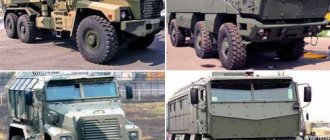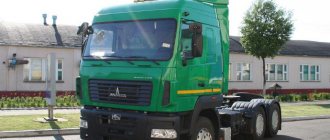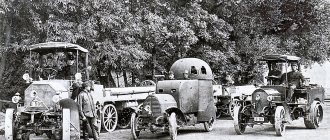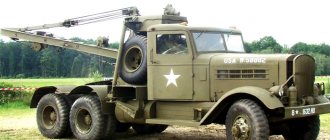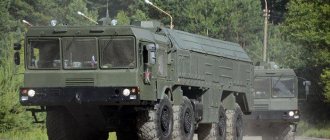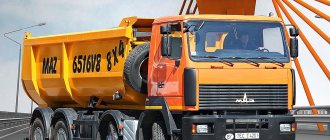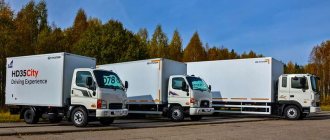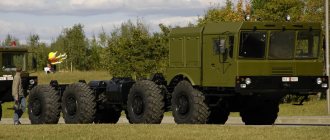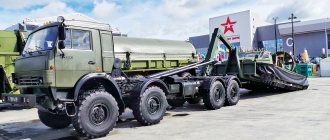A specific feature of combat operations at the end of the last century was the massive use of ambushes and road mining. Within the framework of the NATO bloc, armored vehicles of the MRAP (Mine Resistant Ambush Protected) category began to be created to protect military personnel from attacks. Typhoon armored vehicles represent the Russian take on such equipment.
It is a pity that the idea of creating such a car arose only after a potential enemy had created a similar one; our troops in Afghanistan lacked it so much.
History of origin
The idea of creating a unified automobile chassis arose in the USSR by the beginning of the 80s. To implement the project, the Garage program was launched, which was closed due to the collapse of the country and the cessation of funding.
The idea was returned only in 2010, when families of armored vehicles with a high degree of unification began to appear again within the framework of the concept of development of the armed forces.
The first prototypes of the vehicles began to be tested in the early summer of 2011 at the Bronnitsy training ground.
The largest factories in the Russian Federation for the production of civilian and military trucks, as well as a number of universities (creating the geometry of the armored hull and developing a hydromechanical transmission) took part in the creation of armored vehicles.
Deliveries of armored vehicles to the troops began at the end of 2014, when the first pilot batch of 30 vehicles was delivered.
KAMAZ-63968 Typhoon-K – video of explosion
https://youtube.com/watch?v=XjimOXQZWs8
KAMAZ-63968 “Typhoon” is part of a new stage in the development of domestic vehicles for the armed forces, since the last time the vehicle platform was adopted was in 1961.
The history of the entire Typhoon family begins in 2010, when the Minister of Defense approved the “Concept for the development of military vehicles of the Armed Forces of the Russian Federation for the period until 2022,” which prescribes the development of highly standardized families of armored vehicles. As a result, a single wheeled cargo platform “Typhoon” was created, providing high protection for the crew, cargo and vehicle components from small arms and landmines. And also on which you can mount various target equipment and create the necessary modifications on the base, such as communication vehicles, mobile artillery systems, truck cranes, UAV transport and launch vehicles, tow trucks, excavators and others.
The creation was carried out by auto specialists, Avtodizel OJSC, GAZ Group, KAMAZ OJSC Scientific and Technical Center, the Steel Research Institute - where the vehicle's armor was designed, the Federal Nuclear Center in Sarov, which calculated the security of the armored hull, which was involved in the creation of armored glass, MSTU named after. N. E. Bauman, who was involved in the development of hydropneumatic suspension and many other companies and research institutes. The need to create such vehicles was dictated by the fact that the bulk of combat losses in the troops occur from the explosion of vehicles in a minefield or from landmines during the movement of columns. In December 2014, the first batch of 30 armored vehicles arrived in the Southern Military District. In January 2015, the Southern Military District received another 20 units.
Design
The armor was made in accordance with level 3b of the NATO classification STANAG 4569, according to which the vehicle can withstand the detonation of high-explosive fragmentation devices weighing 8 kg in TNT equivalent under any place in the vehicle, since this is the first time that vehicles of this kind are being made in Russia and there are no generally accepted state standards for the classification of explosions. Bulletproof protection corresponds to the fourth level.
Combined ceramic and steel armor is installed, which protects against armor-piercing bullets of 14.5x114 mm caliber. Including armored glass with a thickness of 128.5-129.0 mm with a transparency of 70%, developed and tested at the Steel Research Institute, which can withstand 2 shots with a distance between them of 280-300 mm when fired from a KPVT with a bullet speed of 911 m/s at the moment of contact with glass. Bullet resistance exceeds the highest requirements according to existing GOSTs (GOST R 51136 and GOST R 50963), in which the highest level is firing with B-32, 7.62x54 mm armor-piercing cartridges from SVD. During production, Magistral-LTD was guided by Western standards of level IV STANAG 4569 - guaranteed protection when fired by armor-piercing ammunition B-32, 14.5 × 114 mm from a distance of 200 m with a bullet speed of 891-931 m/s.
The armor can withstand hits from 30mm ammunition. There are bulletproof tires 16.00R20 with anti-explosive inserts that remove the blast wave, with automatic air pumping and adjustable pressure up to 4.5 atmospheres. The armored module is equipped with embrasures for firing from small arms, and a remote-controlled machine gun can also be installed on it. Unification with other cars of the family is 86%.
The seats are equipped with personal weapon holders, seat belts and headrests. They are attached to the roof of the module to reduce the impact of mines/land mines. An FVUA-100A filter and ventilation unit and an air conditioner are installed inside the module. There are emergency hatches on the roof in case the car overturns. Landing is carried out through a ramp at the rear of the vehicle or through a door on the side.
Surveillance and communications equipment
The car is equipped with an Onboard Information and Control System (BIUS) GALS-D1M for monitoring and regulating engine operation, calculating vehicle roll, road inclination, speed, location, etc. Independent hydropneumatic suspension allows the driver to change the ride height on the go, using remote control within 400mm. KAMAZ-63968 is equipped with five video cameras for all-round visibility in the landing module and cabin. The cabin is equipped with folding monitors showing both the vehicle's condition and external visibility.
General design
The Typhoon project vehicles use a six-cylinder in-line diesel engine of the YaMZ 536 model as the power plant. The vehicle engine has a cylinder displacement of 6.65 liters and develops power from 177 to 450 horsepower. Power is regulated by boost pressure and the use of various fuel injection nozzles. Due to the use of a turbocharger, the torque has increased significantly, reaching 1568 N/m.
In addition to the engine, the vehicle suspension, mine protection screens on the bottom, as well as electronic modules of the driver and crew control and information system are unified. The roof of the cars is adapted for the installation of remotely controlled machine gun installations.
The hull armor corresponds to the fourth level and is made based on a combination of steel sheets and ceramic elements. The armor guarantees protection against penetration by armor-piercing bullets of 14.5 mm caliber (B-32 type bullet).
The armored vehicle can withstand the explosion of a TNT charge weighing up to 8 kg under any point of the hull (level 3D according to the standard NATO classification).
The roof of the vehicle is armored and equipped with air intakes for the ventilation unit. Filters are used in the air supply system. There are folding hatches on the roof of the armored vehicle. The design provides for the installation of a rotating turret for a KPVT machine gun or an automatic gun with a caliber of up to 30 mm.
The design of the Typhoon armored vehicles contains a large proportion of imported components. Axles, a transfer case, and hydropneumatic adjustable suspension with a built-in tire pressure regulation system are supplied from abroad.
The tires of the cars are also imported, allowing you to continue driving at a speed of 50 km/h if damaged. The service life of a punctured tire depends on the amount of damage and reaches 50 km.
Principles of cooperation between the Moscow Region and car factories
For the Ministry of Defense and automobile industry enterprises, the issues of further technical improvement of manufactured car models, the creation of new, more efficient models and the organization of their mass production are of great importance. To solve them, fundamental principles of joint work have been developed.
Firstly, a qualitative increase in the technical level of the cars being created is required. The Ministry of Defense will finance only those works that will bring a significant increase in the main performance characteristics, and will purchase only those samples that are more consistent with the requirements and purpose. Factories can and should engage in phased modernization at their own expense during mass production. The dominant principle remains the creation of military vehicles as part of unified families of various classes of carrying capacity and purpose.
Secondly, it is necessary to minimize the costs of developing and mastering the production of new types of automotive equipment by implementing the “dual-use” principle. There is a danger that this could lead to the “washing out” of a number of the most important indicators of the tactical and technical requirements mandatory for army vehicles: cross-country ability, suitability for maintenance and repair in military conditions, and the use of imported components.
Thirdly, the economic growth of enterprises in the automotive industry makes it possible to plan production development for the long term. In this regard, the parties are trying to find a harmonious combination of programs for the development of vehicle designs of different types and the development of military automotive equipment. For example, the development of commercial vehicles is now in conflict with the requirements for military vehicles. This applies to the widespread use of imported components and developed components, assemblies and vehicle systems on domestic vehicles that cannot be used in the design of military vehicles.
In turn, manufacturing enterprises must have a clear idea of the volume of purchases by the Defense Ministry of their products in order to plan the necessary investments in R&D and development of the production of army vehicles, determine the range and quantity of necessary technological equipment, payback periods for investments and other indicators. The allocated budget allocations will allow the Ministry of Defense to finance the development of only new models of automotive equipment, and the preparation of production and the organization of mass production will be carried out at the expense of manufacturing enterprises.
It is interesting to trace the prospects for the development of automobile enterprises with specific proposals to the Moscow Region. Let's start with the Ulyanovsk Automobile Plant as a manufacturer of the smallest army vehicles.
Tactical and technical characteristics of the Typhoon armored vehicle in comparison with analogues
| Oshkosh M-ATV | Cougar | KamAZ-53949 | |
| A country | USA | Russia | |
| Length, mm | 6270 | 5910 | 5910 |
| Width, mm | 2490 | 2740 | 2448 |
| Height, mm | 2700 | 2640 | 3318 |
| Ground clearance, mm | — | 410 | 433 |
| engine's type | Turbocharged diesel | ||
| Power, hp | 370 | 330 | 350 |
| Highway speed, km/h | 105 | 105 | 105 |
| Cruising range on the highway, km | 515 | 515 | 850 |
Sappers are waiting for the "Tick"
On the eve of the start of serial deliveries of Typhoon-VDV armored vehicles to the troops, Deputy Minister of Defense Alexey Krivoruchko made a working trip to Naberezhnye Chelny. On average, this plant produces about 300 armored vehicles per year for law enforcement agencies; in 2020, Remdizel produced 250 armored vehicles for the Ministry of Defense under the State Defense Order. Alexey Krivoruchko discussed with the management of the enterprise the progress of the State Defense Order and the execution of government contracts, as well as the work being carried out at the enterprise in the areas of import substitution of foreign components and the production of armored vehicles of a new model range.
In addition to the armored car for the Russian Airborne Forces, Remdizel produces other protected vehicles of the Typhoon line for use in the Armed Forces. These are special vehicles of different classes and different wheel formulas. Thus, specifically for escorting military convoys in a high-risk zone, in 2022 the Russian troops will receive the first batch of the latest “Partner” armored vehicles. Also, Remdizel specialists prepared a new armored mining vehicle, Kleshch, for state testing. This mobile minelayer, like the Partner, is based on the Typhoon-VDV armored vehicle.
While the “Kleshch” is being tested in the engineering units of the Russian Armed Forces in the first half of 2021, the industry supplied 25 special vehicles of the SAGR demining group. The vehicles were delivered to engineering units of military districts, the Northern Fleet and units of the Russian Aerospace Forces.
© mil.ru
In the first half of 2021, 25 special vehicles of the SAGR demining group were delivered to the engineering units of the Russian Armed Forces.
The special vehicle of the demining team was created on the basis of the UAZ-2363 pickup truck. It is designed to perform the tasks of operational demining of terrain and infrastructure, transportation of sappers and allows you to transport explosive objects (HE) of the 1st degree of danger without fuses to the place of destruction. The SAGR special equipment includes a capsule body, an ETC-l container, a rack for stowing and transporting high explosives, metal boxes for transporting blasting equipment and explosives, means for explosion localization and an automatic fire extinguishing system.
Modifications
The Typhoon family of armored vehicles includes several vehicles with hood and hoodless configurations. Armored vehicles are produced by different enterprises and differ in some components, as well as in the degree of localization of component production.
KamAZ 63968 Typhoon K
The machine is a modular design that does not have a hood. The car is based on an original three-axle chassis, on which an armored body with enhanced protection is mounted.
The vehicle cabin is equipped with a windshield with a thickness of up to 129 mm, capable of withstanding a double hit from a KPVT bullet at a distance of no closer than 280 mm from each other. The firing distance is 200 m. Today, the Russian army has at least 260 KamAZ 63968 vehicles.
KamAZ-63969 "Typhoon-K"
The armored vehicle is a variant 63968, equipped with a 6x6 all-wheel drive system and remotely controlled weapons. The place to place an installation with a large-caliber machine gun or a small-caliber cannon is the roof of the armored hull.
The troop compartment and the two-seater driver's cabin are a single module without internal partitions.
The vehicle's armor provides perimeter protection against 14.5 mm (Vladimirov machine gun) and 12.7 mm (NATO standard) bullets.
The car was presented to the general public in the summer of 2013 in the assembly shop of the KamAZ plant. Claimed curb weight is 19,700kg, with a payload of up to 4,000kg. The capacity of the troop compartment is 10 people. Serial production of the armored vehicle was not launched.
KamAZ-53949 "Typhoon" 4x4
An armored reconnaissance two-axle vehicle was introduced in 2013. The finalization of the vehicle took almost 5 years, the first serial deliveries are expected no earlier than the summer of 2022.
The crew of the vehicle consists of 4 people. The delivery set includes a sliding mast designed for installing a radar antenna. The armament of the armored vehicle consists of a portable 12.7 mm machine gun. The vehicle is equipped with an unmanned aerial vehicle equipped with optical and radar surveillance systems.
The sensitivity of the systems makes it possible to detect a single person at a distance of up to 6000 m, and an armored vehicle - up to 15 km.
Ural-63095 "Typhoon-U"
A hooded armored vehicle with a frame structure, equipped with three axles and a load capacity of 4000 kg. The design of the machine uses an electronic control module that receives data from transmission units, engine, and electrical equipment.
The control compartment of the armored vehicle is equipped with three seats, access is through the side hinged doors.
The windshield is two-section, glued into the opening of the armored frame. The frame is attached to the machine body with bolts. To prevent fogging, the glass has a heating system.
The combat compartment of the vehicle is equipped with a folding ramp located in the rear. The floor has a multi-layer structure, which reduces the likelihood of penetration during an explosion. There are windows and loopholes on the sides. The windows of the armored vehicle are equipped with armored curtains. The ventilation system has an air conditioner with a supply air filtration system.
There is an autonomous fire extinguishing system. Personnel of 14 people are seated on individual seats with an explosion energy absorption system.
The machine is offered for export. Export versions are completed at the customer's request and can be equipped with:
- identification plates and explanations in a foreign language;
- changed color of paintwork;
- foreign-made transmission;
- standard equipment in the cabin is replaced by foreign ones or is not installed.
Ural-63099 "Typhoon-U"
The machine has a frame structure with a bonnet design, three drive axles and a single-volume body. The vehicle is designed to transport units of combined arms and rifle brigades. The driver's cabin of the armored vehicle is equipped with two seats and is built according to a frame-panel design.
The cabin armor and glass provide protection from bullets with a caliber of up to 14.5 mm.
The machine is equipped with a hydromechanical transmission with six forward gears. The armored vehicle gearbox consists of a planetary gearbox and a torque converter with locking capabilities. On the side surface of the crankcase there is a hatch for installing a power take-off, which is used to operate the hydraulic pump.
The ride height control system and the drives of the ramp installed in the rear of the machine operate from hydraulics. Torque from the gearbox is transmitted to a two-stage transfer case of the ZF VG2000 or MP-1500 brand with a low range. The armored vehicle's gearbox is manually controlled through an electro-pneumatic actuator and is equipped with a built-in center differential that can be locked.
The output shafts of the machine's transfer case rotate the axles using cardan shafts. The central axle of the armored vehicle is of a pass-through design, which made it possible to reduce the drive shafts in the transmission. There is no option to disable the front axle drive. The transfer case is used to drive an additional power take-off.
Preemptive move
Under these conditions, the domestic industry took a smart step - it began the proactive development of the Typhoon-K (KAMAZ) and Typhoon-U (Ural) families of protected vehicles. This was facilitated by the change in the leadership of GABTU in July 2009, which actively began to push for this work at all levels. But this did not mean that the equipment would be in demand among the troops (the scientific substantiation was slowed down, since in the summer and autumn of 2010 there was a reorganization and reassignment of 21 research institutes).
Since the fall of 2011, prototypes, which had not even had time to be tested, began to be shown at international exhibitions, including abroad. As a result, the plans of the leadership of the Russian Ministry of Defense for the purchase of foreign protected vehicles (Mine Resistant Ambush Protected - MRAP according to foreign classification) in the Typhoon payload class were never publicly announced.
In November 2012, Anatoly Serdyukov was dismissed. The appointed Minister of Defense Sergei Shoigu and the Chief of the General Staff Valery Gerasimov smoothly set out to purchase predominantly domestic equipment, while simultaneously trying to deal with the inheritance they inherited, including intermediary companies of imported equipment, systems and components.
Lobbying "Typhoons" in all possible ways, including involving the media, did its job: even under the previous leadership of the RF Ministry of Defense, government contracts were signed to carry out development work (R&D) with the codes "Typhoon-K" and "Typhoon-U" (executors: KAMAZ OJSC and AZ Ural OJSC, respectively). The factories received orders from the Russian Ministry of Defense for the production of pilot batches of 30 units of vehicles with a 6x6 wheel arrangement in variants that can roughly be called “armored taxis” (“Ural-63095U” and KAMAZ-63968).
Projected upgrades
One of the promising developments is the KamAZ-4386 or Typhoon-D hooded armored car, equipped with two axles and intended for arming airborne troops. The armored vehicle is adapted for landing and is equipped with a remote-controlled turret with a heavy machine gun. To lighten the design of the vehicle, a load-bearing armored hull is used.
The design made it possible to reduce weight by 2 tons compared to the 53949 machine.
The power unit is expected to be a 350-horsepower Cummins diesel engine and an automatic transmission with two axles. The design speed of the vehicle exceeds 105 km/h, and the range on the highway is up to 1200 km.
GAS
At the Gorky Automobile Plant there are several directions for the development of military automotive equipment. And first of all, this is the development of the Sadko family of cars. Having inherited the best cross-country ability from the legendary GAZ-66, the cars of the family received the MMZ D-245 diesel engine. Currently, developments are underway to install a diesel engine produced by YaMZ on Sadko cars and increase the tow load on the car to 3 tons.
The GAZ-2330 “Tiger” vehicles, which represent another important line of GAZ military vehicles, have already become widely known. These cars, equipped with a powerful Cummins engine with a manual or automatic transmission, have high dynamic properties
There are two versions of these vehicles: a protected one, with a body for a crew of up to 10 people - for the Ministry of Defense and other law enforcement agencies, and a civilian vehicle with various cargo-passenger bodies. In the civilian version, cars have been produced by the plant since 2005, and cars for the Ministry of Defense are now completing state tests.
The GAZ-39371 Vodnik vehicles were developed by order of the Russian Ministry of Defense and marked the beginning of a new generation of military vehicles with modular bodies. This design of Vodnik vehicles makes it possible to unify the chassis for vehicles for various purposes, including combat, utility or ambulance. If necessary, the combat module can be moved from a failed chassis to the chassis of a support vehicle, which increases the survivability of combat units. Currently, Vodnik cars are produced at the Arzamas machine-building plant in two versions: with the YaMZ-534.10 (160 hp) and GAZ-5621 (175 hp) diesel engines, as well as in two rear module configurations - with a combat module BPU-1 and with a module for transporting personnel.
The Gorky Automobile Plant also has a completely new family of cars with a modular body design, which can be supplied to law enforcement agencies. We are talking about the “Punisher” family of vehicles with a carrying capacity of 1...2 and 5 tons. These vehicles, created by order of the RF Ministry of Defense on the principle of “dual use”, can be used both in the army and in civilian conditions (accordingly simplified). The family may include passenger (command) vehicles and chassis with 4x4 and 6x6 wheel arrangements for mounting weapons or special equipment.
A separate area of GAZ’s work is the creation and production of tracked vehicles. Currently, the main tracked vehicle is the GAZ-34039 floating snow and swamp-going vehicle with a D-254.12 diesel engine produced by the Zavolzhsky Tracked Tractor Plant. In 2007, it is planned to release the GAZ-34039 with a more powerful D-245.7 engine.
Since 2005, serial production of a small-sized tracked snow and swamp-going vehicle in the cargo version of the GAZ-34091 “Beaver” has been launched, and preparations for the production of the passenger modification of the “Beaver” - GAZ-3409 are being completed. The experimental-industrial batch of “Bobrov” has already proven itself well in summer and winter cross-country runs in the Far North, in the middle zone and in the mountains.
To replace its predecessors with gasoline engines, the modernized multi-purpose armored transporter-tractor GAZ-3402D with a 136-horsepower diesel engine D-245.9 has been tested since 2003. Among the promising developments of ZZGT in the field of tracked tractors, we can note the floating two-link dual-purpose conveyor GAZ-3340 of an especially light weight category with a carrying capacity of 2 tons. There are all the prerequisites for the creation in the future on its basis of a whole family of transporters for military and national economic purposes.
Interesting facts and combat use
During testing, the armored capsule was tested for resistance to fragments from a high-explosive projectile with a caliber of 152 mm. When a shell explodes at a distance of 2 meters from the vehicle, the fragments do not penetrate the body of the armored vehicle.
To protect the vehicle body from cumulative ammunition, it is proposed to use elastic mats connected using belts or Velcro fasteners. The design of the mats does not allow the formation of a directed cumulative jet, reducing the likelihood of penetration.
Several vehicles of the KamAZ 63968 type were used in 2022 in Syria to support sappers in clearing mines in liberated cities. There is no other data on the combat use of the vehicles.
UAZ
Today, the Ulyanovsk Automobile Plant's model range consists of three families of vehicles: Hanter, Patriot, LCV and MPV (all-wheel drive commercial minibuses and trucks, in other words, UAZ-2206 and UAZ-3303). The main development of UAZ vehicles is aimed at using a single unit platform on which three different families of engines will be installed: gasoline ZMZ-409.10 (Euro 2), diesel ZMZ-5143.10 (Euro 2) and imported diesel engine (Euro 3, 4), as well as common mechanical 5-speed gearbox made by South Korean Dymos, two-speed transfer case UAZ and solid axles made by UAZ. Already this year, most of the plans should be implemented on production cars, in particular the installation of Dymos gearboxes on all cars. In 2007, it is planned to install imported diesel engines on the Patriot family, and in 2008, the development of a new exterior and interior for the same Patriot family.
The Ulyanovsk Automobile Plant has developed a new UAZ-2970 car with a diesel-electric motor-transmission unit. A vehicle with a ZMZ-5143 diesel engine is equipped with a generator and two traction motors. Together with MAMI, a completely new modular body of a command vehicle with the possibility of hidden armor has been created, which, if desired, can be installed on the UAZ-2970 chassis.
Supplies
Such widespread use of the vehicle allowed strategic military formations to solve almost all current tasks related to transportation. The engineering troops were equipped with a universal truck in the required volume. Last December, the new military KamAZ "Typhoon" began to arrive in military units. The advanced design has a high degree of survivability; The most vulnerable point of all army transporters - the bottom - of the modern Typhoon has received enhanced armor protection.

